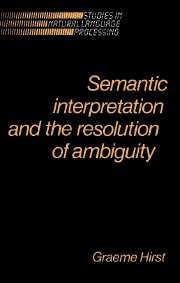2 - Semantic interpretation
Published online by Cambridge University Press: 18 December 2009
Summary
Introduction
In this chapter, I look at previous approaches to semantics and semantic interpretation in linguistics and NLU. The work I will examine addresses one or more of the following questions:
What kind of formalism, representation, or model can adequately capture the semantics of a natural language utterance? That is, what is a “semantic object“?
What kind of process can map a natural language utterance to these semantic objects?
Can these semantic objects be used in artificial intelligence applications? Once a sentence has been interpreted, how can its meaning be applied by the system to which it was input?
All three questions are of interest to AI researchers, but linguists care only about the first two and philosophers only about the first. We should therefore not be surprised or too disappointed if, in looking at work on semantics outside AI, we find that it stops short of where we wanted to go. Conversely, we may also find that a semantic theory is adequate for AI without satisfying the linguists or philosophers.
It is worth emphasizing the point that our concerns in semantics are not identical to everyone else's. We can identify two distinct (but obviously related) concerns (cf.Winograd 1984):
The study of abstract meaning and its relation to language and the world.
The study of how agents understand the meaning of a linguistic utterance in the world.
Too often the label doing semantics is used vaguely to mean one or the other of these, or some random, shifting mixture of both, and the word semantics is unwittingly used differently by different participants in discussions.
- Type
- Chapter
- Information
- Semantic Interpretation and the Resolution of Ambiguity , pp. 25 - 43Publisher: Cambridge University PressPrint publication year: 1987



